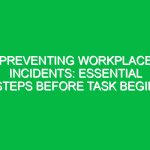Introduction
In the realm of Health, Safety, and Environment (HSE), toolbox talks serve as a cornerstone for fostering a culture of safety within the workplace. A toolbox talk is a short, informative meeting held at the job site, typically before work begins. Its primary goal is to address specific safety topics relevant to the tasks at hand, ensuring that employees are aware of potential hazards and best practices. Engaging workers in these discussions not only enhances their understanding of safety protocols but also empowers them to take ownership of their safety and that of their colleagues.
The importance of toolbox talks cannot be overstated. They provide a platform for open communication, allowing team members to voice concerns, share experiences, and learn from one another. This article will delve into the essential aspects of toolbox talks within the HSE domain, offering practical tips and insights for conducting effective sessions that promote a safer work environment.
Understanding Toolbox Talks in HSE
Defining Toolbox Talks
Toolbox talks are brief safety meetings usually held on-site, focusing on specific topics related to health and safety in the workplace. These discussions can cover a wide array of subjects, including risk assessments, equipment usage, emergency procedures, and safe work practices. Often conducted by supervisors or safety officers, toolbox talks are designed to be interactive and engaging, allowing participants to ask questions and contribute to the conversation.
The Relevance of Toolbox Talks
The relevance of toolbox talks in the HSE context lies in their ability to bridge the gap between theoretical safety training and practical application. While formal safety training provides essential knowledge, toolbox talks allow employees to contextualize that knowledge in real-world scenarios. For instance, a construction site may have a formal training session on fall prevention, but a toolbox talk can address specific fall hazards present on that site, such as unguarded edges or slippery surfaces.
Key Components of an Effective Toolbox Talk
Preparation
Preparation is crucial for an effective toolbox talk. Before the meeting, identify relevant topics based on current tasks, recent incidents, or recurring safety issues. Gather any necessary materials, such as safety data sheets or visual aids, to support your discussion. This preparation phase also includes selecting a suitable time and place for the talk, ensuring that all team members can participate without distractions.
Engagement
Engaging employees during toolbox talks is vital for ensuring that the information resonates. Use open-ended questions to encourage discussion and invite team members to share their experiences related to the topic. For example, if discussing the use of personal protective equipment (PPE), ask participants to share instances where they felt PPE was lacking or where it played a crucial role in their safety.
Clear Communication
Effective communication is at the heart of every successful toolbox talk. Use clear, concise language and avoid technical jargon that may confuse participants. When discussing safety protocols, break down complex information into manageable parts. Visual aids, such as diagrams or videos, can help reinforce key points, making the information more accessible.
Documentation
Documenting toolbox talks is essential for tracking safety training and compliance. Keep a record of the topics discussed, attendees, and any action items that arise during the meeting. This documentation not only serves as a reference for future talks but also demonstrates an organization’s commitment to safety, which can be beneficial during audits or inspections.
Benefits of Toolbox Talks
Promotes Safety Awareness
Regular toolbox talks promote a heightened awareness of safety issues among employees. By discussing specific hazards and safety measures, workers become more vigilant and proactive in identifying potential risks. This increased vigilance can lead to a significant reduction in accidents and injuries on the job site.
Encourages Open Communication
Toolbox talks create an environment where employees feel comfortable discussing safety concerns. This open line of communication is essential for identifying hazards that may not be immediately apparent to supervisors or safety officers. When workers actively participate in safety discussions, they are more likely to report unsafe conditions or behaviors.
Strengthens Team Cohesion
Conducting toolbox talks can also strengthen team cohesion. These meetings provide an opportunity for team members to bond over shared experiences and challenges. As employees collaborate to address safety issues, they develop a sense of camaraderie that can enhance overall workplace morale and cooperation.
Best Practices for Conducting Toolbox Talks
Keep It Short and Focused
Toolbox talks should be brief, typically lasting no more than 15 to 30 minutes. This time frame ensures that participants remain engaged and retain the information presented. Focus on one specific topic during each talk to avoid overwhelming employees with too much information at once.
Utilize Real-Life Examples
Incorporating real-life examples into toolbox talks enhances their relevance and impact. Share stories of past incidents—whether from your own workplace or industry-wide case studies—to illustrate the importance of the topic. By connecting the discussion to tangible experiences, employees can better understand the potential consequences of neglecting safety protocols.
Encourage Participation
Encouraging participation during toolbox talks fosters a sense of ownership among employees. Invite team members to share their thoughts, questions, and suggestions related to the topic. This collaborative approach not only enriches the discussion but also empowers workers to take an active role in their safety.
Follow Up
Following up after a toolbox talk is crucial for reinforcing the information shared. Address any action items that arose during the discussion and ensure that necessary changes are implemented. This follow-up demonstrates a commitment to safety and encourages employees to engage in future toolbox talks with the understanding that their input is valued.
Potential Hazards and Safety Considerations
Identifying Hazards
During toolbox talks, it’s essential to identify and discuss potential hazards specific to the work environment. This could include anything from chemical exposure to equipment malfunctions. By highlighting these dangers, employees can develop a clear understanding of what to watch for and how to mitigate risks.
Implementing Safety Measures
In addition to identifying hazards, toolbox talks should emphasize the importance of implementing safety measures. Discuss appropriate PPE, safe handling procedures, and emergency response protocols. Employees should leave the talk with a concrete understanding of how to protect themselves and their colleagues.
Regulations and Standards
OSHA Regulations
In the United States, the Occupational Safety and Health Administration (OSHA) has established regulations governing workplace safety. While OSHA does not mandate toolbox talks, they are considered a best practice for meeting various safety training requirements. Organizations that conduct regular toolbox talks can demonstrate compliance with OSHA standards, thereby reducing the risk of fines or penalties.
ISO Standards
Internationally, the International Organization for Standardization (ISO) has developed standards related to occupational health and safety, such as ISO 45001. This standard emphasizes the importance of worker involvement in safety practices, aligning closely with the objectives of toolbox talks. By adhering to ISO standards, organizations can enhance their safety management systems and improve overall workplace safety.
Conclusion
In summary, toolbox talks are a vital component of effective HSE safety practices. They provide a structured yet flexible approach to discussing safety issues, fostering a culture of awareness and engagement among employees. By preparing thoroughly, encouraging participation, and documenting discussions, organizations can maximize the impact of these talks.
The benefits of toolbox talks extend beyond compliance; they promote a safer, more cohesive work environment where employees feel empowered to prioritize safety. As we navigate the complexities of workplace safety, let us remember the importance of open communication and proactive measures. By integrating toolbox talks into our daily routines, we can cultivate a culture that values health, safety, and environmental sustainability for all.


